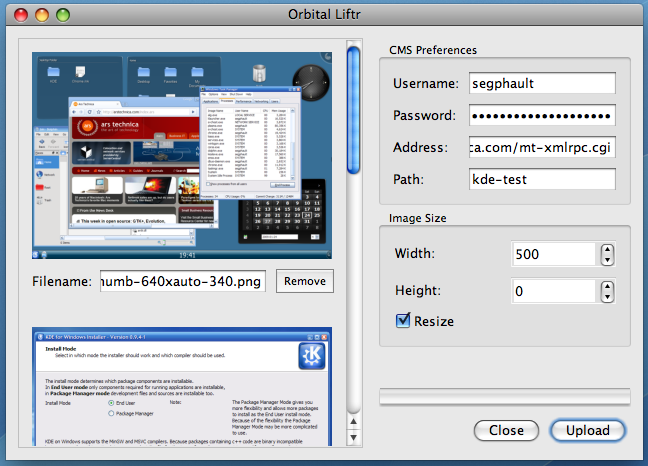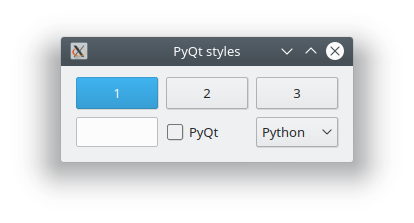macOS (previously known as OS X or Mac OS X) is Apple's operating system for the Mac line of computers. It's a UNIX platform, based on the Darwin kernel, and behaves largely similar to other UNIX-like platforms. The main difference is that X11 is not used as the windowing system. Instead, macOS uses its own native windowing system that is accessible through the Cocoa API.
To download and install Qt for macOS, follow the instructions on the Getting Started with Qt page.

Download PyQt for free. The GPL licensed Python bindings for the Qt application framework. PyQt is the Python bindings for Digia's Qt cross-platform application development framework. It supports Python v2 and v3 and Qt v4 and Qt v5. PyQt4 for Mac OS X 4.12.3 freeware download - Brings together the Qt C cross-platform application framework - Freeware downloads - best freeware - Best Freeware Download.
Supported Versions
When talking about version support on macOS, it's important to distinguish between the build environment; the platform you're building on or with, and the target platforms; the platforms you are building for. The following macOS versions are supported.
Download Pyqt For Mac Versions
| Target Platform | Architecture | Build Environment |
|---|---|---|
| macOS 10.13, 10.14, 10.15 | x86_64 and x86_64h | Xcode 11 (10.15 SDK) |
Build Environment
The build environment on macOS is defined entirely by the Xcode version used to build your application. Xcode contains both a toolchain (compiler, linker, and other tools), and a macOS platform-SDK (headers and libraries). Together these define how your application is built.
Note: The version of macOS that you are running Xcode on does not matter. As long as Apple ships a given Xcode version that runs on your operating system, the build environment will be defined by that Xcode version.

Xcode can be downloaded from Apple's developer website (including older versions of Xcode). Once installed, choosing an Xcode installation is done using the xcode-select tool.
You can inspect the globally selected Xcode installation using the same tool.
The xcrun command can then be used to find a particular tool in the toolchain.
or show the platform SDK path used when building.
Target Platforms
Building for macOS utilizes a technique called weak linking that allows you to build your application against the headers and libraries of the latest platform SDK, while still allowing your application to be deployed to macOS versions lower than the SDK version. When the binary is run on a macOS version lower than the SDK it was built with, Qt will check at runtime whether or not a platform feature is available before utilizing it.
In theory this would allow running your application on every single macOS version released, but for practical (and technical) reasons there is a lower limit to this range, known as the deployment target of your application. If the binary is launched on a macOS version below the deployment target macOS or Qt will give an error message and the application will not run.
Qt expresses the deployment target via the QMAKE_MACOSX_DEPLOYMENT_TARGET qmake variable, which has a default value set via the makespec for macOS. You should not need to change this default, but if needed you can increase it in your project file:
Note: You should not lower the deployment target beyond the default value set by Qt. Doing so will likely lead to crashes at runtime if the binary is then deployed to a macOS version lower than what Qt expected to run on.
By always building against the latest available platform SDK, you ensure that Qt can take advantage of new features introduced in recent versions of macOS.
For more information about SDK-based development on macOS, see Apple's developer documentation.
Opting out of macOS behavior changes
One caveat to using the latest Xcode version and SDK to build your application is that macOS's system frameworks will sometimes decide whether or not to enable behavior changes based on the SDK you built your application with.
For example, when dark-mode was introduced in macOS 10.14 Mojave, macOS would only treat applications built against the 10.14 SDK as supporting dark-mode, and would leave applications built against earlier SDKs with the default light mode look. This technique allows Apple to ensure that binaries built long before the new SDK and operating system was released will still continue to run without regressions on new macOS releases.
A consequence of this is that if Qt has problems dealing with some of these macOS features (dark-mode, layer-backed views), the only way to opt out of them is building with an earlier SDK (the 10.13 SDK, available through Xcode 9). This is a last-resort solution, and should only be applied if your application has no other ways of working around the problem.
Architectures
By default, Qt is built for x86_64. To build for x86_64h (Haswell). use the QMAKE_APPLE_DEVICE_ARCHSqmake variable. This is selectable at configure time:
QMAKE_APPLE_DEVICE_ARCHS can also be specified as a space-delimited list in order to build for multiple architectures simultaneously:
Additional Command-Line Options
Download Pyqt For Mac Windows 7
On the command-line, applications can be built using qmake and make. Optionally, qmake can generate project files for Xcode with -spec macx-xcode. If you are using the binary package, qmake generates Xcode projects by default; use -spec macx-gcc to generate makefiles. For example:
Configuring with -spec macx-xcode generates an Xcode project file from project.pro. With qmake you do not have to worry about rules for Qt's preprocessors (moc and uic) since qmake automatically handles them and ensures that everything necessary is linked into your application.
Qt does not entirely interact with the development environment (for example plugins to set a file to 'mocable' from within the Xcode user interface).
The result of the build process is an application bundle, which is a directory structure that contains the actual application executable. The application can be launched by double-clicking it in Finder, or by referring directly to its executable from the command line, for example, myApp.app/Contents/MacOS/myApp.
If you wish to have a command-line tool that does not use the GUI for example, moc, uic or ls, you can tell qmake to disable bundle creation from the CONFIG variable in the project file:
Deploying Applications on macOS
macOS applications are typically deployed as self-contained application bundles. The application bundle contains the application executable as well as dependencies such as the Qt libraries, plugins, translations and other resources you may need. Third party libraries like Qt are normally not installed system-wide; each application provides its own copy.
A common way to distribute applications is to provide a compressed disk image (.dmg file) that the user can mount in Finder. The deployment tool, macdeployqt (available from the macOS installers), can be used to create the self-contained bundles, and optionally also create a .dmg archive. Applications can also be distributed through the Mac App Store. Qt 5 aims to stay within the app store sandbox rules. macdeployqt (bin/macdeployqt) can be used as a starting point for app store deployment.
Note: For selling applications in the macOS App Store, special rules apply. In order to pass validation, the application must verify the existence of a valid receipt before executing any code. Since this is a copy protection mechanism, steps should be taken to avoid common patterns and obfuscate the code that validates the receipt as much as possible. Thus, this cannot be automated by Qt, but requires some platform-specific code written specifically for the application itself. More information can be found in Apple's documentation.
macOS Issues
The page below covers specific issues and recommendations for creating macOS applications.
Where to Go from Here
We invite you to explore the rest of Qt. We prepared overviews to help you decide which APIs to use and our examples demonstrate how to use our API.
- Qt Overviews - list of topics about application development
- Examples and Tutorials - code samples and tutorials
- Qt Reference Pages - a listing of C++ and QML APIs
Qt's vibrant and active community site, http://qt.io houses a wiki, a forum, and additional learning guides and presentations.
© 2020 The Qt Company Ltd. Documentation contributions included herein are the copyrights of their respective owners. The documentation provided herein is licensed under the terms of the GNU Free Documentation License version 1.3 as published by the Free Software Foundation. Qt and respective logos are trademarks of The Qt Company Ltd. in Finland and/or other countries worldwide. All other trademarks are property of their respective owners.
In the last article, I introduced you to Qt and its Python interfaces, PyQt and PySide; now that you know a bit about them, pick one and install it. I recommend PySide for two reasons: first, this tutorial is conceived in terms of PySide, and may cover a few topics that are less fully-implemented in PyQt; and second, its licensing is more flexible for your future use. Either one will work, however.
The following will show you how to install PySide and PyQt on Windows, Mac and Linux. Binary installers are available for most common platforms; links and setup instructions are outlined below:

Installation of PySide or PyQt is by a simple point-and-click installer on Windows. For PySide, get the appropriate binary for your version of Python from releases.qtproject.com. Run the installer, confirming the location of your Python installation (which should be correctly auto-detected) and optionally selecting an installation directory, and you should have a working PySide installation in seconds.
PyQt is much the same, except that you can choose only a partial installation instead of a full one: don't. You'll want the examples and demos. They're worth the space. Get the PyQt installers from Riverbank.
Mac OS X binaries to install PySide are available from the Qt Project.
For PyQt, use the binaries provided by the PyQtX project. Choose the complete version for your Python version, which supplies Qt as well as PyQt, unless you're certain that you have Qt installed in the correct version; then use the minimal installers.
If you're using Homebrew, you can do:
or
from the command line. You can also use MacPorts:
changing NN to match your Python version. Similarly, you can do:
to install PyQt.
For Debian- and Ubuntu-based Linux distributions, installation of PySide or PyQt is simple; just do:
from the command line. For PyQt:
Alternatively, use Synaptic to install your choice of python-pyside or python-qt4.
Installation of PySide or PyQt is also simple for most RPM-based distros using yum; just do:
as root from the command line to install PySide. For PyQt, do
Now that you have an installation of PySide or PyQt, we are almost ready to begin learning to use it — but first, we must discuss editors and IDEs. We'll do so in our next installment.
